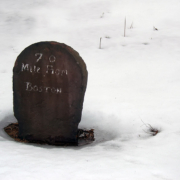The Boston Post Road
The Boston Post Road was the first postal route between Boston and New York. The three different routes
or alignments were: Upper Post Road, Lower Post Road, and Middle Post Road. Portions of these postal
roads were eventually incorporated into more substantial trails and pathways, leading to portions of several
U.S. and interstate routes.
Before European settlers colonized North America, Native Americans had established trails that were
used frequently. These paths eventually became portions of post roads, which were used by post riders
to deliver mail to the early colonists. The first portions of the Boston Post Road were laid out in 1673,
becoming America’s first mail route. In the 1700s, riders carried the Boston News-Letter, widely considered America’s first
regular newspaper, along the Boston Post Road with regular mail, sharing information with settlers and connecting towns along
the route.
In 1753, then-Deputy Postmaster Benjamin Franklin traveled the Boston Post Road to standardize postal rates based on
distance. Stone markers were placed at mile points along the route. In 1783, the Boston Post Road carried America’s first
long-distance stagecoach service from New York to Boston, corresponding with improvements in the road’s surface that resulted
in a faster, safer, and more efficient transportation system. The success of the stagecoach service along this route convinced
Congress to send mail by stagecoach instead of a lone rider.
In 1925, when the federal government asked each state to designate its principal routes, the Massachusetts public works chief
picked two branches of the Boston Post Road as U.S. Route 1 and U.S. Route 20.

 Neil Sargent
Neil Sargent